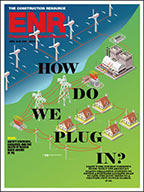Britain's Huge Offshore Wind Farm Faces An Array of Challenges
With steelwork fabrication about to start, designers for the world’s largest offshore wind farm are scrambling to redesign the first 175 turbine foundations. A generic foundation fault at several European wind farms is the latest squall the U.K.’s 1,000-MW London Array must navigate.

“We have been asked to change the design,” says Jasper Jacobsen, project director at ABJV, the development’s construction joint venture. The team includes Denmark’s Per Aarsleff A/S, Aabyhoej, and Bilfinger Berger A.G., Mannheim, Germany. “It's a challenge, but it can be done,” he says.
Design Problem
With nearly 280 turbines spread over 250 sq kilometers of the Thames Estuary, London Array ultimately will raise Europe’s offshore wind-power capacity by more than 60%. Each of its towers will sit on a transition piece (TP), fitting like a sleeve over the top of a steel-tube “monopile” 4.7 to 5.7 meters dia. These piles will be driven into the seabed and extend upward through up to 25 m of water, breaking the surface by a few meters.
Two offshore substations, each on a monopile, will step up the electric voltage generated by the turbines. Electricity will flow from the turbines along 20-km-plus subsea lines to an onshore substation, now being built at Cleve Hill, Kent.
After nearly a decade’s development, the owner, London Array Ltd. (LAL), six months ago confirmed contracts worth nearly $3 billion for the first 630 MW, to be completed in 2012. But by then, Norway’s project certification company, Sandvik, Norway-based Det Norske Veritas, had initiated reviews of its widely used design guidance.
“[Test] showed during the early fall of 2009 that parts of the calculation basis needed to be improved,” explains a DNV official. Investigations disclosed failures in the bonding between the monopiles and the transition pieces.
London Array’s TPs will overlap the monopiles by about 8 m and rise 20 m above water, providing a platform for the turbine towers. The entire 440-tonne weight of each turbine and tower will be transferred by friction through grout injected into the few centimeters of space between the overlapping TP and monopile. Until now, monopiles and TPs have been cylindrical.
Reports of grout failures shattered the credibility of that design, which allowed the TPs and towers to settle. So far, TPs seem to have been held a few centimeters below correct levels by internal steelwork brackets for positioning jacks used during installation. The brackets are not a permanent solution, say project staff.
While engineers on troubled towers look for remedies, a new design has emerged. DNV’s guidelines now require overlapping sections of monopiles and TPs to be conical, with sides sloping by about 1°. If grout fails, the TPs would settle no more than about 20 cm before resting on the monopile’s sloping walls.
Under its roughly $520-million contract, ABJV is handling all offshore installation and turnkey construction of monopiles and TPs. Its lead designer, Copenhagen, Denmark’s COWI A/S, submitted initial engineering reports a few months ago. However, “We were [told] to change the design,” says Jan Rønberg, project director.
As a construction management veteran, LAL’s project director Richard Rigg takes the latest snag in stride. For nearly 10 years, he has steered the wind farm’s development through several tempests.
In late 2006, “we had the interesting position of full consent for 1,000 MW offshore but no means of connecting [the array] onshore,” Rigg says. Local officials in Kent objected to LAL’s onshore substation design, which has been revised.
Offshore, LAL hit another obstacle. The agency’s environmental impact assessment found...





